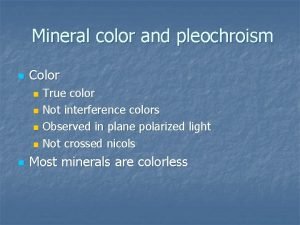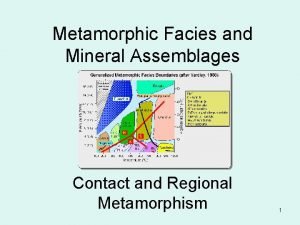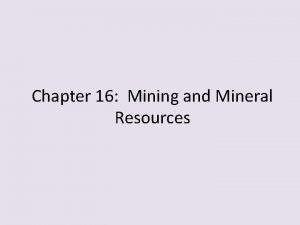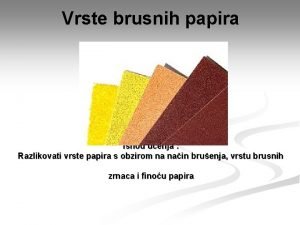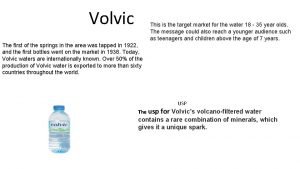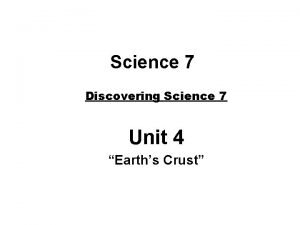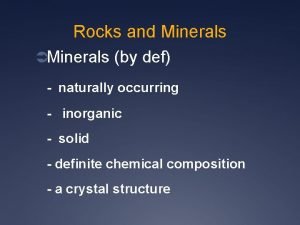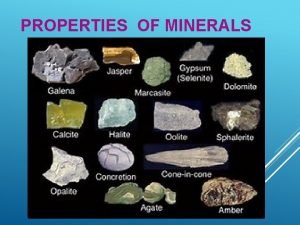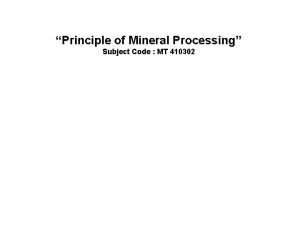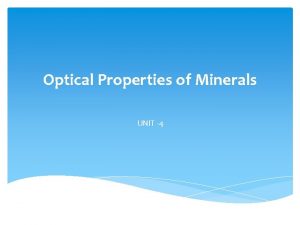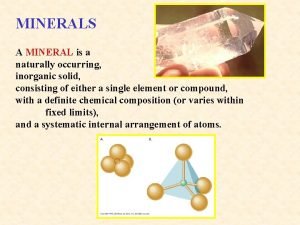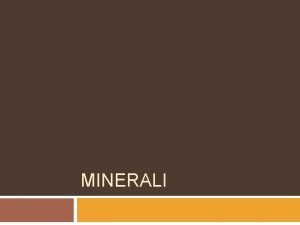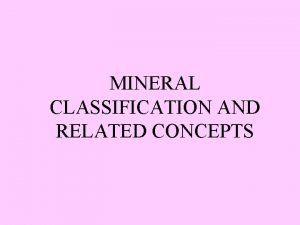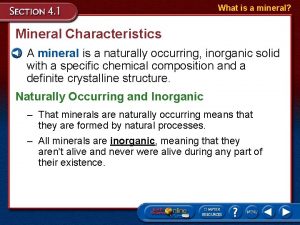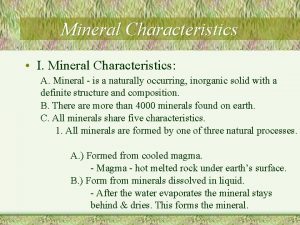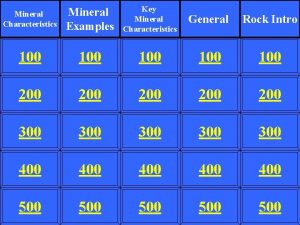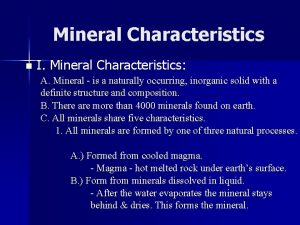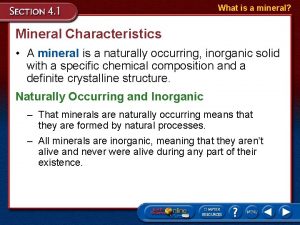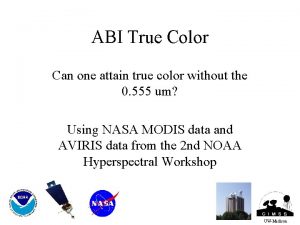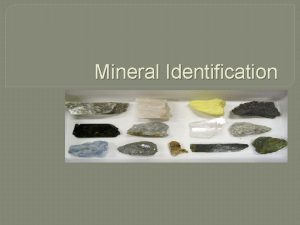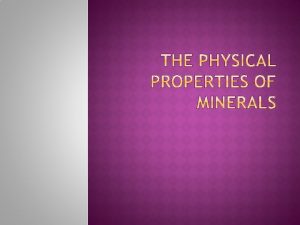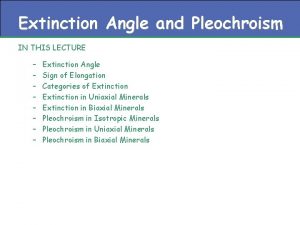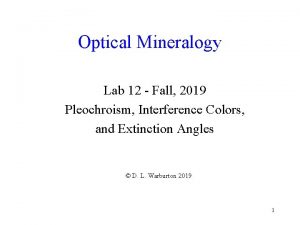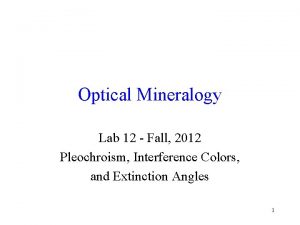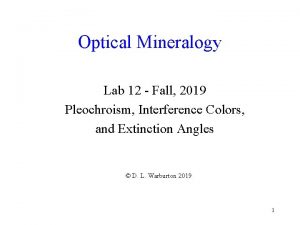Mineral color and pleochroism n Color True color





















- Slides: 21

Mineral color and pleochroism n Color True color n Not interference colors n Observed in plane polarized light n Not crossed nicols n n Most minerals are colorless

Pleochroism n Property of having two or more true colors Occurs only in anisotropic minerals n Each principal vibration direction has a unique color n Preferentially absorbs selected wavelengths of light n

Pleochroism – Glaucophane (amphibole – Na, Mg, Fe – Silicate) Pleochroism – orthopyroxene – (Ca, Fe, Mg – Silicate)

n Color depends on which vibration direction parallels polarized direction Slow ray has one color n Fast ray another color n Color intermediate if neither direction parallel to polarized direction n n Pleochroic formula n Relationship of color to index of refraction (a, b, g, e, w) that shows the color

Pleochroic formula n Multiple types of formulas: 1. 2. 3. Color of e, w, a, b, or g rays Greater absorbance e. g. w > e or e > w “strongly” or “weakly” pleochroic

Determination of formula – uniaxial minerals n Find grain with d = 0 n n This is value of w color Find grain with maximum d This has both e and w n Already know w, so other color must be e n

Direction of polarized light Grains seen in plane polarized light (not crossed nicols) • 1 st grain (not shown) – complete extinction • Viewed in plane polarized light gives w color • 2 nd grain (shown) – provides w and e colors • Since know w already, the other color is e • Determine fast and slow with accessory plate Fig. 7 -30

Biaxial Pleochroism n Biaxial minerals may have three colors: n n One for a, b, and g Procedure similar to uniaxial minerals, but more complex Find extinct section – b color n Find maximum d – this grain has a and g colors n Determine fast and slow direction with accessory plate n

n n Vibration directions parallel to accessory plate If addition, color associated with ng If subtraction, color associated with na Remember – check color without analyzer in na ng Fig. 7 -31

Extinction n Four Categories: Parallel extinction – feature (usually cleavage) parallel to cross hairs at extinction n Inclined extinction – extinction when feature is at an angle to cross hairs n Symmetrical extinction – occurs in minerals with two cleavages: bisect cleavage n No extinction angle – minerals with no elongation or cleavage n

Parallel Symmetrical Inclined No extinction angle Fig. 7. 32

Extinction may not be uniform n n n Physically deformed minerals Minerals with variable chemical composition (chemically zoned) Undulatory Extinction Zoned Extinction

Extinction angle n Inclined extinction - angle between long axis of mineral grain n prominent cleavage n Twins n Other crystallographic feature n

Extinction angle Long direction, also parallel to cleavage • Rotate stage until crystallographic feature is parallel to cross hairs • Record angle on goniometer • Rotate stage until mineral is extinct • Now mineral vibration direction is parallel to polarized light direction • Amount of rotation is extinction angle Fig. 7 -31

n Possible to determine chemical composition from extinction angle n Michel-Levy technique

Michel-Levy Technique Section cut perpendicular to {010} Albite twin lamellae b c b a Cut of mineral must be with {010} plane vertical, b crystallographic axis horizontal b Na. Al. Si 3 O 8 Ca. Al 2 Si 2 O 8 Characteristics: High plagioclase = volcanic • Sharp boundaries between twins Low plagioclase = plutonic • Twin lamellae have same interference colors Fig. 12. 15 & 12. 17

Albite Na-feldspar Na. Al. Si 3 O 8 Z b X b Z X An 0 to An 10 An 30 to An 50 Z Z b X An 50 to An 70 b X An 90 to An 100 Feldspars - Triclinic minerals: • Two cleavages • Many types of twins Extinction angles show relationship between X-Y -Z axes (indicatrix axes) and a-b-c axes (crystallographic axes) Anorthite Ca-feldspar Ca. Al 2 Si 2 O 8 p. 245

Sign of Elongation n Length fast: elongate direction of mineral parallels fast vibration direction n n Length slow: elongate direction of mineral parallels slow vibration direction n n Also called negative elongation Also called positive elongation Length fast and length slow depends on cut of grain

Determination n n Orient grain with vibration direction and length about 45º to polarized direction Use accessory plate to determine addition or subtraction of retardation n Determines if fast or slow ray

n n n Vibration directions parallel to accessory plate If addition, length slow (positive elongation) If subtraction, length fast (negative elongation) Length fast Length slow Fig. 7 -31

Orthorhombic Minerals (biaxial) ng = elongate Always length slow na = elongate nb = elongate Always length fast Either length slow or length fast
 Pleochroic formula
Pleochroic formula Chapter 2 jesus christ true god and true man
Chapter 2 jesus christ true god and true man Amer rasheed
Amer rasheed Mineral resources and petroleum authority of mongolia
Mineral resources and petroleum authority of mongolia Metamorphic
Metamorphic Chapter 13 mineral resources and mining
Chapter 13 mineral resources and mining What is primary emulsion
What is primary emulsion Mineral exploration and mining active reading
Mineral exploration and mining active reading Portfolio committee on mineral resources and energy
Portfolio committee on mineral resources and energy Brusni papir za vodeno brušenje
Brusni papir za vodeno brušenje Volvic definition
Volvic definition Mineral vs organic soil
Mineral vs organic soil Discovering science 7
Discovering science 7 Minerals def
Minerals def How a mineral reflects light from its surface
How a mineral reflects light from its surface 2 product formula mineral processing
2 product formula mineral processing Resemisasi
Resemisasi Basal section mineral
Basal section mineral Inorganic mineral definition
Inorganic mineral definition Mineral vs element
Mineral vs element Microelementi
Microelementi Minerals found in karnataka
Minerals found in karnataka
